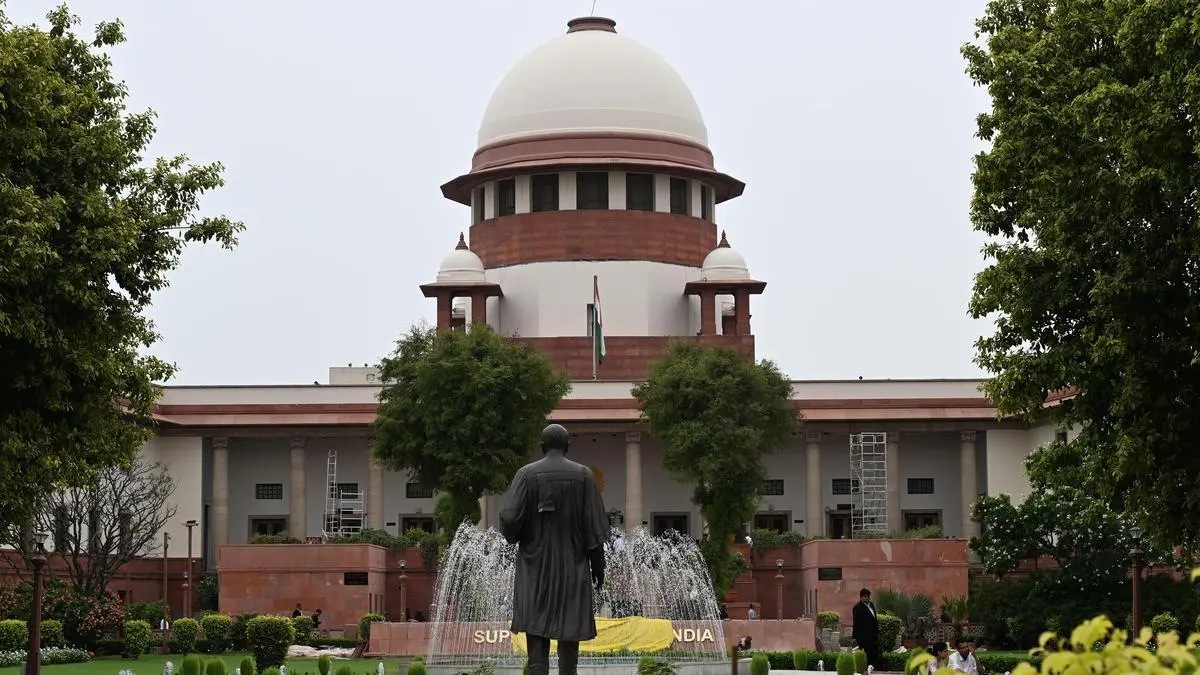GIFT NIFTY -131 (25820) from last trade 25951
Nikkei -666 pts ,
Hangseng -413 pts ,
Now @6.52am .
Dow -797.60 pts ,Nsdq -536.10 pts, S&P +113.43 pts , Bovespa -470 pts , Ftse -103 pts , Dax -339 pts , Cac -8 pts , Crude @ $58.90 brl (+0.21) Brent @ $63.11 brl (-0.40) , Gold @ 4182.90 (-11.60), Silver @ $52.405 (-0.76), Euro @ $1.1626 , JPY @ $154.64 , INR @ 88.785
Today’s Corporate Action
14-11 Ex Date
ANZEN\u0009
Income Distribution (InvIT)
BAYERCROP\u0009
Interim Dividend – Rs. – 90.0000
BSOFT\u0009
Interim Dividend – Rs. – 2.5000
DLINKINDIA\u0009
Interim Dividend – Rs. – 6.0000
GANESHCP\u0009
Interim Dividend – Rs. – 2.5000
GARFIBRES\u0009
Interim Dividend – Rs. – 8.0000
GHCL\u0009
Buy Back of Shares \u0009
INDAG\u0009
Interim Dividend – Rs. – 0.9000
INDIGRID\u0009
Income Distribution (InvIT)
INFY\u0009
Buy Back of Shares \u0009
INTERISE\u0009
Income Distribution (InvIT)
JMFINANCIL\u0009
Interim Dividend – Rs. – 1.5000
KPEL\u0009
Interim Dividend – Rs. – 0.2500
KPGEL\u0009
Interim Dividend – Rs. – 0.2500
KPIGREEN\u0009
Interim Dividend – Rs. – 0.2500
MAFATIND\u0009
Interim Dividend – Rs. – 1.2500
MIT\u0009
Income Distribution (InvIT)
NATIONALUM\u0009
Interim Dividend – Rs. – 4.0000
NAVA\u0009
Interim Dividend – Rs. – 3.0000
ONGC\u0009
Interim Dividend\u0009
PREMCO\u0009
Special Dividend – Rs. – 36.0000
PRICOLLTD\u0009
Interim Dividend – Rs. – 2.0000
SAKSOFT\u0009
Interim Dividend\u0009
SAMPRE\u0009
Bonus issue 1:1\u0009
SAMPRE\u0009
Stock Split From Rs.10/- to Rs.5/-
SMCGLOBAL\u0009
Bonus issue 1:1\u0009
WEBELSOLAR\u0009
Stock Split From Rs.10/- to Rs.1/-
Today’s Board Meetings
14-11 Ex Date
\u0009 \u0009
A1L\u0009
Bonus issue;Stock Split;Interim Dividend;General
A2ZINFRA\u0009
Quarterly Results\u0009 \u0009
AAPLUSTRAD\u0009
Half Yearly Results\u0009 \u0009
AARTECH\u0009
General;Quarterly Results\u0009
ABHISHEK\u0009
Quarterly Results\u0009 \u0009
ABINFRA\u0009
Quarterly Results\u0009 \u0009
ABMKNO\u0009
Quarterly Results\u0009 \u0009
ACCURACY\u0009
Quarterly Results\u0009 \u0009
ACEEDU\u0009
Quarterly Results\u0009 \u0009
ACFL\u0009
Quarterly Results\u0009 \u0009
ACSTECH\u0009
Quarterly Results\u0009 \u0009
ADARSHPL\u0009
General;Quarterly Results\u0009
ADCON\u0009
Quarterly Results\u0009 \u0009
ADDIND\u0009
Quarterly Results\u0009 \u0009
ADHHATA\u0009
Quarterly Results\u0009 \u0009
ADITYASP\u0009
Quarterly Results\u0009 \u0009
ADJIA\u0009
Half Yearly Results\u0009 \u0009
ADTECH\u0009
Quarterly Results\u0009 \u0009
ADVIKLA\u0009
Quarterly Results\u0009 \u0009
AGIIL\u0009
Quarterly Results\u0009 \u0009
AGRIBIO\u0009
Quarterly Results\u0009 \u0009
AGRITECH\u0009
Quarterly Results\u0009 \u0009
AHASOLAR\u0009
Half Yearly Results;General\u0009
AHLUCONT\u0009
Quarterly Results\u0009 \u0009
AIHL
Quarterly Results\u0009 \u0009
AIKPIPES\u0009
Half Yearly Results\u0009 \u0009
AIMCOPEST\u0009
Quarterly Results\u0009 \u0009
AIML\u0009
General;Quarterly Results\u0009
AIRAN\u0009
General;Quarterly Results\u0009
AJANTSOY\u0009
Quarterly Results\u0009 \u0009
ALCHCORP\u0009
Quarterly Results\u0009 \u0009
ALFATRAN\u0009
Quarterly Results\u0009 \u0009
ALFAVIO\u0009
Quarterly Results\u0009 \u0009
ALLCARGO\u0009
Quarterly Results\u0009 \u0009
ALNATRD\u0009
Quarterly Results\u0009 \u0009
ALPA\u0009
Quarterly Results\u0009 \u0009
ALPHAGEO\u0009
General;Quarterly Results\u0009
ALPSINDUS\u0009
Quarterly Results\u0009 \u0009
AMARSEC\u0009Quarterly Results\u0009 \u0009
AMBIT\u0009Quarterly Results\u0009 \u0009
AMITSEC\u0009Quarterly Results\u0009 \u0009
AMPVOLTS\u0009Quarterly Results\u0009 \u0009
AMRAPLIN\u0009Quarterly Results\u0009 \u0009
AMTL\u0009Quarterly Results\u0009 \u0009
ANG\u0009General;Quarterly Results\u0009
ANIKINDS\u0009General;Quarterly Results\u0009
ANKIN\u0009Quarterly Results\u0009 \u0009
ANNAINFRA\u0009Quarterly Results\u0009 \u0009
ANSINDUS\u0009Quarterly Results\u0009 \u0009
APCL\u0009Quarterly Results\u0009 \u0009
APIL\u0009Quarterly Results\u0009 \u0009
APIS\u0009Quarterly Results\u0009 \u0009
ARCHIES\u0009Quarterly Results\u0009 \u0009
ARCOTECH\u0009Quarterly Results;General\u0009
ARIGATO\u0009Quarterly Results\u0009 \u0009
ASCENSIVE\u0009Half Yearly Results\u0009 \u0009
ASHNI\u0009General;Quarterly Results\u0009
ASHOKA\u0009Quarterly Results\u0009 \u0009
ASIAN\u0009Quarterly Results\u0009 \u0009
ASIANHOTNR\u0009Quarterly Results\u0009 \u0009
ASIANTNE\u0009Quarterly Results\u0009 \u0009
ASIL\u0009Quarterly Results\u0009 \u0009
ASTRON\u0009Quarterly Results\u0009 \u0009
ATAM\u0009Quarterly Results\u0009 \u0009
ATHENAGLO\u0009Quarterly Results\u0009 \u0009
ATLANTAA\u0009Quarterly Results\u0009 \u0009
AUTOPINS\u0009Quarterly Results\u0009 \u0009
AVONMORE\u0009Quarterly Results\u0009 \u0009
AXISOL\u0009Quarterly Results\u0009 \u0009
AXITA\u0009General;Quarterly Results\u0009
BAJEL\u0009Quarterly Results\u0009 \u0009
BALGOPAL\u0009Quarterly Results\u0009 \u0009
BALUFORGE\u0009General;Quarterly Results\u0009
BANG\u0009Quarterly Results\u0009 \u0009
BARODARY\u0009General;Quarterly Results\u0009
BASF\u0009Quarterly Results\u0009 \u0009
BASML\u0009Quarterly Results\u0009 \u0009
BBTC\u0009Quarterly Results\u0009 \u0009
BBTCL\u0009Quarterly Results\u0009 \u0009
BCG\u0009Quarterly Results\u0009 \u0009
BCLENTERPR\u0009Quarterly Results\u0009 \u0009
BETXIND\u0009Quarterly Results\u0009 \u0009
BGDL\u0009Quarterly Results\u0009 \u0009
BGRENERGY\u0009Quarterly Results\u0009 \u0009
BHAGWOX\u0009Quarterly Results\u0009 \u0009
BHANDARI\u0009Quarterly Results\u0009 \u0009
BHANDERI\u0009Half Yearly Results\u0009 \u0009
BHARATGEAR\u0009Quarterly Results\u0009 \u0009
BHUDEVI\u0009Quarterly Results\u0009 \u0009
BI\u0009General;Quarterly Results\u0009
BILLWIN\u0009Half Yearly Results\u0009 \u0009
BINDALEXPO\u0009Half Yearly Results\u0009 \u0009
BLKASHYAP\u0009Quarterly Results\u0009 \u0009
BLOIN\u0009Quarterly Results\u0009 \u0009
BLOOM\u0009General;Quarterly Results\u0009
BORANA\u0009Quarterly Results\u0009 \u0009
BOSTONBIO\u0009Quarterly Results\u0009 \u0009
BRAWN\u0009Quarterly Results\u0009 \u0009
BRIGHT\u0009Increase in Authorised Capital;Half Yearly Results
BRISK\u0009Half Yearly Results\u0009 \u0009
BROOKS\u0009Quarterly Results\u0009 \u0009
BTML\u0009General;Quarterly Results\u0009
BTTL\u0009Quarterly Results\u0009 \u0009
BVL\u0009Half Yearly Results\u0009 \u0009
CALSOFT\u0009Preferential Issue of shares;Increase in Authorised Capital;Quarterly Results;General
CAPRICORN\u0009Quarterly Results\u0009 \u0009
CAPRO\u0009Quarterly Results\u0009 \u0009
CARRARO\u0009Quarterly Results\u0009 \u0009
CASPIAN\u0009Quarterly Results\u0009 \u0009
CCHHL\u0009General;Quarterly Results\u0009
CCLINTER\u0009Quarterly Results\u0009 \u0009
CEENIK\u0009General;Quarterly Results\u0009
CEETAIN\u0009General;Quarterly Results\u0009
CENLUB\u0009Quarterly Results\u0009 \u0009
CENTEXT\u0009Quarterly Results\u0009 \u0009
CEREBRAINT\u0009Quarterly Results\u0009 \u0009
CGFL\u0009General;Quarterly Results\u0009
CGVAK\u0009Quarterly Results;General\u0009
CHEMIESYNT\u0009Quarterly Results\u0009 \u0009
CHOKSILA\u0009General;Quarterly Results\u0009
CHPLIND\u0009General;Quarterly Results\u0009
CIFL\u0009Quarterly Results\u0009 \u0009
CITURGIA\u0009Quarterly Results\u0009 \u0009
CLENON\u0009Preferential Issue of shares;Quarterly Results
COMPEAU\u0009Quarterly Results\u0009 \u0009
CONART\u0009Quarterly Results\u0009 \u0009
CORAGRO\u0009Quarterly Results\u0009 \u0009
CORALAB\u0009Quarterly Results\u0009 \u0009
COSCO\u0009Quarterly Results\u0009 \u0009
COSYN\u0009Quarterly Results\u0009 \u0009
COUNCODOS\u0009Quarterly Results;General\u0009
CPCAP\u0009Quarterly Results\u0009 \u0009
CPML\u0009Half Yearly Results;Quarterly Results
CRANEINFRA\u0009Quarterly Results\u0009 \u0009
CRAVATEX\u0009Quarterly Results\u0009 \u0009
CRPRISK\u0009Half Yearly Results;General\u0009
CRSL\u0009Quarterly Results\u0009 \u0009
CRYSDALE\u0009General;Quarterly Results\u0009
DAICHI\u0009Quarterly Results\u0009 \u0009
DATIWARE\u0009Quarterly Results\u0009 \u0009
DAULAT\u0009Quarterly Results\u0009 \u0009
DBEIL\u0009Quarterly Results\u0009 \u0009
DBREALTY\u0009Increase in Authorised Capital;Quarterly Results;General
DCL\u0009Half Yearly Results\u0009 \u0009
DCMNVL\u0009General;Quarterly Results\u0009
DDEVPLSTIK\u0009Quarterly Results\u0009 \u0009
DECOMIC\u0009Quarterly Results\u0009 \u0009
DEEPAKCHEM\u0009Half Yearly Results\u0009 \u0009
DEKSON\u0009Quarterly Results\u0009 \u0009
DEL\u0009Quarterly Results\u0009 \u0009
DHAMPURE\u0009Quarterly Results\u0009 \u0009
DHANCOT\u0009General;Quarterly Results\u0009
DIAMANT\u0009Quarterly Results\u0009 \u0009
DIKSAT\u0009Half Yearly Results\u0009 \u0009
DILIGENT\u0009Quarterly Results\u0009 \u0009
DISHTV\u0009Quarterly Results\u0009 \u0009
DITCO\u0009Quarterly Results\u0009 \u0009
DNAMEDIA\u0009Quarterly Results\u0009 \u0009
DPWIRES\u0009General;Quarterly Results\u0009
DRL\u0009Quarterly Results\u0009 \u0009
DSKULKARNI\u0009Quarterly Results\u0009 \u0009
DSSL\u0009Quarterly Results\u0009 \u0009
DUCON\u0009Quarterly Results\u0009 \u0009
DUKEOFS\u0009Quarterly Results;General\u0009
DUROPLY\u0009Quarterly Results\u0009 \u0009
EARKART\u0009Employees Stock Option Plan;Half Yearly Results;General
EARTH\u0009Half Yearly Results\u0009 \u0009
EASTWEST\u0009Quarterly Results\u0009 \u0009
ECS\u0009Quarterly Results\u0009 \u0009
ECSTSTL\u0009Quarterly Results\u0009 \u0009
EDVENSWA\u0009Quarterly Results\u0009 \u0009
EIGHTY\u0009Half Yearly Results\u0009 \u0009
EKC\u0009Quarterly Results\u0009 \u0009
ELIXIR\u0009Quarterly Results\u0009 \u0009
EMMBI\u0009Quarterly Results\u0009 \u0009
EMMSONS\u0009Quarterly Results\u0009 \u0009
EMSLIMITED\u0009Quarterly Results\u0009 \u0009
ENGINERSIN\u0009Quarterly Results\u0009 \u0009
EPUJA\u0009Quarterly Results;General\u0009
ETIL\u0009Quarterly Results\u0009 \u0009
EXIDEIND\u0009Quarterly Results\u0009 \u0009
EXPLICITFIN\u0009Quarterly Results\u0009 \u0009
EY\u0009Quarterly Results\u0009 \u0009
FFPL\u0009Quarterly Results\u0009 \u0009
FIBERWEB\u0009Quarterly Results\u0009 \u0009
FILME\u0009Quarterly Results\u0009 \u0009
FIRSTCRY\u0009Quarterly Results\u0009 \u0009
FIRSTFIN\u0009Quarterly Results\u0009 \u0009
FLOMIC\u0009Quarterly Results\u0009 \u0009
FLUIDOM\u0009General;Quarterly Results\u0009
FMNL\u0009Quarterly Results\u0009 \u0009
FORINTL\u0009Quarterly Results\u0009 \u0009
FRONTCAP\u0009Quarterly Results\u0009 \u0009
FRONTCORP\u0009Quarterly Results\u0009 \u0009
FRONTFN\u0009Quarterly Results\u0009 \u0009
GAJANANSEC\u0009Quarterly Results\u0009 \u0009
GALADA\u0009Quarterly Results\u0009 \u0009
GALADAFIN\u0009Quarterly Results\u0009 \u0009
GANGAPA\u0009Quarterly Results\u0009 \u0009
GANGESSECU\u0009General;Quarterly Results\u0009
GANGOTRI\u0009Quarterly Results\u0009 \u0009
GANVERSE\u0009Half Yearly Results\u0009 \u0009
GARBIFIN\u0009Quarterly Results\u0009 \u0009
GARGFUR\u0009Quarterly Results\u0009 \u0009
GARNET\u0009Quarterly Results\u0009 \u0009
GARNETINT\u0009General;Quarterly Results\u0009
GBGLOBAL\u0009General;Quarterly Results\u0009
GENESIS\u0009Quarterly Results\u0009 \u0009
GENNEX\u0009Quarterly Results\u0009 \u0009
GENUSPRIME\u0009Quarterly Results\u0009 \u0009
GETALONG\u0009Half Yearly Results\u0009 \u0009
GGPL\u0009Quarterly Results\u0009 \u0009
GKB\u0009Quarterly Results\u0009 \u0009
GLENMARK\u0009Quarterly Results\u0009 \u0009
GLOBUSCON\u0009Quarterly Results\u0009 \u0009
GLOTTIS\u0009Quarterly Results\u0009 \u0009
GMDCLTD\u0009Quarterly Results\u0009 \u0009
GNRL\u0009Quarterly Results\u0009 \u0009
GODAVARI\u0009Quarterly Results\u0009 \u0009
GOKAKTEX\u0009Quarterly Results\u0009 \u0009
GORANIN\u0009Quarterly Results\u0009 \u0009
GPIL\u0009Quarterly Results;General\u0009
GTEIT\u0009Quarterly Results;General\u0009
GTLINFRA\u0009Quarterly Results\u0009 \u0009
GUFICBIO\u0009General;Quarterly Results\u0009
GUJAPOLLO\u0009General;Quarterly Results\u0009
GVFILM\u0009Quarterly Results\u0009 \u0009
GVKPIL\u0009Quarterly Results\u0009 \u0009
HALDER\u0009Quarterly Results\u0009 \u0009
HANMAN\u0009Half Yearly Results\u0009 \u0009
HARIAAPL\u0009Quarterly Results\u0009 \u0009
HARIAEXPO\u0009Quarterly Results\u0009 \u0009
HARSHILAGR\u0009General;Quarterly Results\u0009
HARYNACAP\u0009Quarterly Results\u0009 \u0009
HASTIFIN\u0009Quarterly Results\u0009 \u0009
HAZOOR\u0009Quarterly Results;General\u0009
HEMACEM\u0009Quarterly Results\u0009 \u0009
HERANBA\u0009General;Quarterly Results\u0009
HERCULES\u0009Voluntary Delisting of Shares;Quarterly Results
HFIL\u0009Quarterly Results\u0009 \u0009
HGM\u0009Quarterly Results\u0009 \u0009
HILIKS\u0009Quarterly Results\u0009 \u0009
HINDOILEXP\u0009Quarterly Results\u0009 \u0009
HIPOLIN\u0009General;Quarterly Results\u0009
HIRAUTO\u0009Quarterly Results\u0009 \u0009
HISARSP\u0009Quarterly Results\u0009 \u0009
HITTCO\u0009Quarterly Results\u0009 \u0009
HLVLTD\u0009Quarterly Results\u0009 \u0009
HMAAGRO\u0009General;Quarterly Results\u0009
ICON\u0009Half Yearly Results;Quarterly Results
ICSL\u0009Quarterly Results\u0009 \u0009
IDENTIXWEB\u0009Half Yearly Results\u0009 \u0009
IFINSER\u0009Quarterly Results\u0009 \u0009
IL&FSENGG\u0009Quarterly Results;General\u0009
IMEC\u0009Quarterly Results\u0009 \u0009
INA\u0009Half Yearly Results\u0009 \u0009
INANISEC\u0009Quarterly Results\u0009 \u0009
INDIAGLYCO\u0009Quarterly Results\u0009 \u0009
INDIANCARD\u0009General;Quarterly Results\u0009
INDNIPPON\u0009Quarterly Results\u0009 \u0009
INDONG\u0009Half Yearly Results\u0009 \u0009
INDOUS\u0009Quarterly Results\u0009 \u0009
INDSUCR\u0009Quarterly Results\u0009 \u0009
INDSWFTLAB\u0009Quarterly Results\u0009 \u0009
INFORTEC\u0009General;Quarterly Results\u0009
INGERRAND\u0009Interim Dividend;Quarterly Results
INNOKAIZ\u0009Half Yearly Results\u0009 \u0009
INNOVANA\u0009General;Quarterly Results\u0009
INNOVTEC\u0009Quarterly Results\u0009 \u0009
INOXGREEN\u0009Quarterly Results\u0009 \u0009
INOXWIND\u0009General;Quarterly Results\u0009
INTECCAP\u0009Quarterly Results\u0009 \u0009
INTRGLB\u0009Quarterly Results\u0009 \u0009
IPOWER\u0009Quarterly Results\u0009 \u0009
IPRINGLTD\u0009Quarterly Results\u0009 \u0009
ISHANCH\u0009Quarterly Results\u0009 \u0009
ITCONS\u0009Half Yearly Results\u0009 \u0009
IVRCLINFRA\u0009Quarterly Results\u0009 \u0009
IWP\u0009Quarterly Results\u0009 \u0009
JAGAJITIND\u0009Quarterly Results\u0009 \u0009
JAIBALAJI\u0009Quarterly Results;General\u0009
JAINCO\u0009Quarterly Results\u0009 \u0009
JAINEX\u0009Right Issue of Equity Shares;Quarterly Results
JAINMARMO\u0009Quarterly Results\u0009 \u0009
JAIPAN\u0009Quarterly Results\u0009 \u0009
JAUSPOL\u0009Quarterly Results\u0009 \u0009
JBFIND\u0009Quarterly Results\u0009 \u0009
JCHAC\u0009Quarterly Results\u0009 \u0009
JETMALL\u0009Issue Of Warrants;General\u0009
JFL\u0009Half Yearly Results\u0009 \u0009
JGCHEM\u0009Quarterly Results\u0009 \u0009
JINDALPOLY\u0009Quarterly Results\u0009 \u0009
JITFINFRA\u0009Quarterly Results\u0009 \u0009
JIYAECO\u0009Quarterly Results\u0009 \u0009
JMGCORP\u0009Quarterly Results\u0009 \u0009
JPTSEC\u0009General;Quarterly Results\u0009
JUNGLECAMP\u0009Quarterly Results\u0009 \u0009
KAJARIR\u0009Quarterly Results\u0009 \u0009
KAKTEX\u0009Quarterly Results\u0009 \u0009
KALLAM\u0009Quarterly Results\u0009 \u0009
KALYANCAP\u0009Quarterly Results\u0009 \u0009
KAMANWALA\u0009General;Quarterly Results\u0009
KANUNGO\u0009Quarterly Results\u0009 \u0009
KARNAVATI\u0009Quarterly Results\u0009 \u0009
KAVDEFENCE\u0009Quarterly Results;General\u0009
KCLINFRA\u0009Quarterly Results\u0009 \u0009
KCSL\u0009Half Yearly Results\u0009 \u0009
KEIL\u0009Quarterly Results\u0009 \u0009
KELENRG\u0009General;Quarterly Results\u0009
KENRIK\u0009Half Yearly Results\u0009 \u0009
KENVI\u0009Quarterly Results\u0009 \u0009
KESARPE\u0009General;Quarterly Results\u0009
KEYFINSERV\u0009General;Quarterly Results\u0009
KFBL\u0009Quarterly Results\u0009 \u0009
KGDENIM\u0009Quarterly Results\u0009 \u0009
KGVL\u0009Half Yearly Results\u0009 \u0009
KHAITANLTD\u0009Quarterly Results\u0009 \u0009
KHAZANCHI\u0009Half Yearly Results\u0009 \u0009
KHYATI\u0009Quarterly Results\u0009 \u0009
KICL\u0009Quarterly Results\u0009 \u0009
KIFS\u0009Quarterly Results\u0009 \u0009
KINGSINFR\u0009General;Quarterly Results\u0009
KIRANSY-B\u0009General;Quarterly Results\u0009
KIRLOSIND\u0009Quarterly Results\u0009 \u0009
KJMCCORP\u0009Quarterly Results\u0009 \u0009
KLGCAP\u0009General;Quarterly Results\u0009
KMEW\u0009Stock Split;Quarterly Results\u0009
KMSMEDI\u0009Half Yearly Results\u0009 \u0009
KOTIC\u0009Quarterly Results\u0009 \u0009
KOURA\u0009Half Yearly Results\u0009 \u0009
KRIDHANINF\u0009Quarterly Results\u0009 \u0009
KRISHNACAP\u0009Quarterly Results\u0009 \u0009
KROSS\u0009General;Quarterly Results\u0009
KSOILS\u0009Quarterly Results\u0009 \u0009
KUMPFIN\u0009Quarterly Results\u0009 \u0009
KUNSTOFF\u0009General;Quarterly Results\u0009
KUWERIN\u0009Quarterly Results\u0009 \u0009
LANCORHOL\u0009Quarterly Results\u0009 \u0009
LANDMARC\u0009Quarterly Results;General\u0009
LASA\u0009Quarterly Results\u0009 \u0009
LASTMILE\u0009General;Quarterly Results\u0009
LAXMIINDIA\u0009Quarterly Results\u0009 \u0009
LEADFIN\u0009Quarterly Results\u0009 \u0009
LEENEE\u0009Quarterly Results\u0009 \u0009
LERTHAI\u0009Quarterly Results\u0009 \u0009
LGLL\u0009Half Yearly Results\u0009 \u0009
LIMECHM\u0009Quarterly Results\u0009 \u0009
LIPPISYS\u0009Quarterly Results\u0009 \u0009
LOGICA\u0009Half Yearly Results;Right Issue of Equity Shares with Warrants
LONGSPUR\u0009Quarterly Results\u0009 \u0009
LOYAL\u0009Quarterly Results\u0009 \u0009
LSIND\u0009Quarterly Results\u0009 \u0009
LYPSAGEMS\u0009General;Quarterly Results\u0009
MAANALU\u0009Quarterly Results;General\u0009
MACH\u0009Preferential Issue of shares;Half Yearly Results
MADHURIND\u0009Quarterly Results\u0009 \u0009
MADHUSE\u0009Quarterly Results\u0009 \u0009
MAIDEN\u0009Half Yearly Results\u0009 \u0009
MAITRI\u0009Quarterly Results\u0009 \u0009
MANAKALUCO\u0009Quarterly Results\u0009 \u0009
MANAKSIA\u0009Quarterly Results\u0009 \u0009
MANGASOF\u0009General;Quarterly Results\u0009
MANOMAY\u0009Quarterly Results\u0009 \u0009
MANORG\u0009General;Quarterly Results\u0009
MARBLE\u0009Quarterly Results\u0009 \u0009
MARICO\u0009Quarterly Results\u0009 \u0009
MAYUR\u0009Quarterly Results\u0009 \u0009
MBLINFRA\u0009Quarterly Results\u0009 \u0009
MCLEODRUSS\u0009Quarterly Results\u0009 \u0009
MCLTD\u0009Quarterly Results\u0009 \u0009
MCPL\u0009Half Yearly Results\u0009 \u0009
MEDICAMEQ\u0009Quarterly Results\u0009 \u0009
MEERA\u0009Interim Dividend;Quarterly Results
METALCO\u0009Quarterly Results\u0009 \u0009
METROGLOBL\u0009General;Quarterly Results\u0009
MFSINTRCRP\u0009Quarterly Results\u0009 \u0009
MIDINDIA\u0009Quarterly Results\u0009 \u0009
MIIL\u0009Quarterly Results\u0009 \u0009
MIL\u0009General;Quarterly Results\u0009
MILESTONE\u0009Quarterly Results\u0009 \u0009
MISQUITA\u0009Half Yearly Results;General\u0009
MKPL\u0009Quarterly Results\u0009 \u0009
MLKFOOD\u0009Quarterly Results\u0009 \u0009
MMFL\u0009Quarterly Results\u0009 \u0009
MODIPON\u0009Quarterly Results\u0009 \u0009
MODIRUBBER\u0009General;Quarterly Results\u0009
MODISONLTD\u0009General;Quarterly Results\u0009
MODTHREAD\u0009Quarterly Results\u0009 \u0009
MOHITE\u0009Quarterly Results\u0009 \u0009
MONARCH\u0009Quarterly Results\u0009 \u0009
MOREPENLAB\u0009Quarterly Results\u0009 \u0009
MPAGI\u0009Quarterly Results\u0009 \u0009
MPKSTEELS\u0009Half Yearly Results\u0009 \u0009
MRCAGRO\u0009Quarterly Results\u0009 \u0009
MRF\u0009Interim Dividend;Quarterly Results
MTEDUCARE\u0009General;Quarterly Results\u0009
MTNL\u0009Quarterly Results\u0009 \u0009
MTPL\u0009Quarterly Results\u0009 \u0009
MUKATPIP\u0009Quarterly Results\u0009 \u0009
MUL\u0009Quarterly Results\u0009 \u0009
MULTIIN\u0009Quarterly Results\u0009 \u0009
MUNOTHFI\u0009Quarterly Results\u0009 \u0009
MYSORPETRO\u0009Quarterly Results\u0009 \u0009
NACDAC\u0009Half Yearly Results\u0009 \u0009
NAGPI\u0009Quarterly Results;General\u0009
NAGREEKCAP\u0009Quarterly Results\u0009 \u0009
NAGREEKEXP\u0009Quarterly Results\u0009 \u0009
NAHARINDUS\u0009Quarterly Results\u0009 \u0009
NARBADA\u0009Quarterly Results\u0009 \u0009
NARMADA\u0009Quarterly Results\u0009 \u0009
NATCOPHARM\u0009Interim Dividend;Quarterly Results
NATGENI\u0009Quarterly Results\u0009 \u0009
NATHIND\u0009Quarterly Results\u0009 \u0009
NATHUEC\u0009Quarterly Results\u0009 \u0009
NATPLAS\u0009Quarterly Results\u0009 \u0009
NBL\u0009Half Yearly Results\u0009 \u0009
NCLIND\u0009Quarterly Results\u0009 \u0009
NDASEC\u0009Quarterly Results\u0009 \u0009
NECCLTD\u0009Quarterly Results\u0009 \u0009
NEELKAN\u0009Quarterly Results\u0009 \u0009
NGIL\u0009Quarterly Results\u0009 \u0009
NH\u0009Quarterly Results\u0009 \u0009
NHL\u0009Half Yearly Results\u0009 \u0009
NIDHGRN\u0009Quarterly Results\u0009 \u0009
NIKSTECH\u0009Half Yearly Results\u0009 \u0009
NILACHAL\u0009Quarterly Results\u0009 \u0009
NILE\u0009Interim Dividend;Quarterly Results
NIMBSPROJ\u0009Quarterly Results\u0009 \u0009
NIRLON\u0009Quarterly Results\u0009 \u0009
NIRMITEE\u0009Half Yearly Results\u0009 \u0009
NITINCAST\u0009Quarterly Results\u0009 \u0009
NIWASSP\u0009Quarterly Results\u0009 \u0009
NMSRESRC\u0009Quarterly Results\u0009 \u0009
NOVIS\u0009Quarterly Results\u0009 \u0009
NPRFIN\u0009Quarterly Results\u0009 \u0009
NRAIL\u0009Quarterly Results\u0009 \u0009
NRINTER\u0009Quarterly Results\u0009 \u0009
NSBBPO\u0009Half Yearly Results\u0009 \u0009
NYSSACORP\u0009General;Quarterly Results\u0009
OBCL\u0009Quarterly Results\u0009 \u0009
OCTAVE\u0009Quarterly Results\u0009 \u0009
OCTAVIUSPL\u0009Quarterly Results\u0009 \u0009
OIL\u0009Quarterly Results;Interim Dividend
OIVL\u0009General;Quarterly Results\u0009
OKPLA\u0009Quarterly Results\u0009 \u0009
OLATECH\u0009Half Yearly Results;General\u0009
OLYOI\u0009Quarterly Results\u0009 \u0009
OMAXE\u0009Quarterly Results;General\u0009
OMKARPH\u0009Quarterly Results\u0009 \u0009
OMNIAX\u0009Quarterly Results\u0009 \u0009
OMNIPOTENT\u0009Half Yearly Results\u0009 \u0009
ONEGLOBAL\u0009General;Quarterly Results\u0009
ONIXSOLAR\u0009Quarterly Results\u0009 \u0009
OONE\u0009General;Quarterly Results\u0009
OPCHAINS\u0009Half Yearly Results\u0009 \u0009
OPTIEMUS\u0009Quarterly Results\u0009 \u0009
ORGCOAT\u0009Quarterly Results\u0009 \u0009
ORIBEVER\u0009Quarterly Results\u0009 \u0009
ORICONENT\u0009Quarterly Results\u0009 \u0009
ORIENTTR\u0009Quarterly Results;General\u0009
OROSMITHS\u0009Quarterly Results\u0009 \u0009
ORTINGLOBE\u0009General;Quarterly Results\u0009
OSIAJEE\u0009Quarterly Results\u0009 \u0009
PACIFICI\u0009Quarterly Results\u0009 \u0009
PADALPO\u0009Quarterly Results\u0009 \u0009
PANACEABIO\u0009Quarterly Results\u0009 \u0009
PANORAMA\u0009General;Quarterly Results\u0009
PAOS\u0009Quarterly Results\u0009 \u0009
PARNAXLAB\u0009Quarterly Results\u0009 \u0009
PARVATI\u0009General;Quarterly Results\u0009
PATELCHEM\u0009Half Yearly Results\u0009 \u0009
PBGLOBAL\u0009Quarterly Results\u0009 \u0009
PBMPOLY\u0009Quarterly Results\u0009 \u0009
PEETISEC\u0009Quarterly Results\u0009 \u0009
PEIL\u0009Quarterly Results\u0009 \u0009
PETPLST\u0009General;Quarterly Results\u0009
PFLINFOTC\u0009Quarterly Results;General\u0009
PHOENIXTN\u0009Quarterly Results\u0009 \u0009
PHRMASI\u0009Quarterly Results\u0009 \u0009
PHYTO\u0009Quarterly Results\u0009 \u0009
PICTUREHS\u0009Quarterly Results\u0009 \u0009
PIONRINV\u0009Quarterly Results\u0009 \u0009
PIXTRANS\u0009Quarterly Results\u0009 \u0009
PJL\u0009Half Yearly Results\u0009 \u0009
PLAZACABLE\u0009General;Quarterly Results\u0009
PNC\u0009Quarterly Results\u0009 \u0009
POEL\u0009Interim Dividend;General;Quarterly Results
POLSON\u0009Quarterly Results\u0009 \u0009
POLYCON\u0009Quarterly Results\u0009 \u0009
POLYSPIN\u0009Quarterly Results\u0009 \u0009
PPL\u0009Quarterly Results\u0009 \u0009
PRABHAVIN\u0009Quarterly Results;General\u0009
PRAKASH\u0009Quarterly Results\u0009 \u0009
PRARUH\u0009Half Yearly Results\u0009 \u0009
PRAVEG\u0009Quarterly Results\u0009 \u0009
PREMSYN\u0009General;Quarterly Results\u0009
PRIMEURB\u0009Quarterly Results\u0009 \u0009
PRIMO\u0009Quarterly Results\u0009 \u0009
PRISMMEDI\u0009Quarterly Results\u0009 \u0009
PROSTARM\u0009General;Quarterly Results\u0009
PSPL\u0009Half Yearly Results\u0009 \u0009
PULSRIN\u0009Quarterly Results\u0009 \u0009
PUROHITCON\u0009Quarterly Results\u0009 \u0009
PURPLE\u0009General;Quarterly Results\u0009
PVP\u0009General;Quarterly Results\u0009
QUESTFLOW\u0009Half Yearly Results;General\u0009
RACHIT\u0009Half Yearly Results\u0009 \u0009
RADAAN\u0009Quarterly Results\u0009 \u0009
RAGHUSYN\u0009Quarterly Results\u0009 \u0009
RAJABAH\u0009Quarterly Results\u0009 \u0009
RAJPUTANA\u0009General;Quarterly Results\u0009
RAJTUBE\u0009Quarterly Results\u0009 \u0009
RAMASTEEL\u0009Quarterly Results\u0009 \u0009
RANASUG\u0009Quarterly Results\u0009 \u0009
RANEHOLDIN\u0009Quarterly Results\u0009 \u0009
RAPID\u0009Half Yearly Results\u0009 \u0009
RATHIGRA\u0009Quarterly Results\u0009 \u0009
RATHIST\u0009Quarterly Results\u0009 \u0009
RATNABHUMI\u0009Quarterly Results\u0009 \u0009
RAUNAQ\u0009Quarterly Results\u0009 \u0009
RCCEMEN\u0009Quarterly Results\u0009 \u0009
RCF\u0009Quarterly Results\u0009 \u0009
RCOM\u0009Quarterly Results\u0009 \u0009
RDBRL\u0009Quarterly Results\u0009 \u0009
REDTAPE\u0009Quarterly Results\u0009 \u0009
RELIABLE\u0009Quarterly Results\u0009 \u0009
RELICAB\u0009General;Quarterly Results\u0009
REMLIFE\u0009Quarterly Results\u0009 \u0009
REPRO\u0009Quarterly Results\u0009 \u0009
RESPONSINF\u0009Quarterly Results\u0009 \u0009
RETAIL\u0009Quarterly Results\u0009 \u0009
REXSEAL\u0009Half Yearly Results\u0009 \u0009
RGF\u0009Quarterly Results\u0009 \u0009
RGRL\u0009General;Quarterly Results\u0009
RIDHISYN\u0009Quarterly Results\u0009 \u0009
RIR\u0009Quarterly Results\u0009 \u0009
RITHWIKFMS\u0009Half Yearly Results\u0009 \u0009
RKDAGRRTL\u0009Quarterly Results\u0009 \u0009
RLFL\u0009Quarterly Results\u0009 \u0009
RMDRIP\u0009Quarterly Results\u0009 \u0009
RNBDENIMS\u0009Quarterly Results\u0009 \u0009
ROOPAIND\u0009General;Quarterly Results\u0009
ROSEMER\u0009Quarterly Results\u0009 \u0009
ROYALCU\u0009Quarterly Results\u0009 \u0009
RRECL\u0009Quarterly Results\u0009 \u0009
RRMETAL\u0009Quarterly Results\u0009 \u0009
RRP\u0009General;Quarterly Results\u0009
RSDFIN\u0009Quarterly Results\u0009 \u0009
RUDRA\u0009Quarterly Results\u0009 \u0009
SADBHAV\u0009Quarterly Results;General\u0009
SAICAPI\u0009Quarterly Results\u0009 \u0009
SAINIK\u0009Quarterly Results\u0009 \u0009
SALGUTI\u0009Quarterly Results\u0009 \u0009
SALSAIN\u0009Quarterly Results\u0009 \u0009
SAMINDUS\u0009Quarterly Results;General\u0009
SAMRATPH\u0009Quarterly Results\u0009 \u0009
SAMTELIN\u0009Quarterly Results\u0009 \u0009
SANBLUE\u0009General;Quarterly Results\u0009
SANCODE\u0009Half Yearly Results;General\u0009
SANGUI\u0009Quarterly Results;General\u0009
SANJIVIN\u0009Quarterly Results\u0009 \u0009
SANPA\u0009Quarterly Results\u0009 \u0009
SANSTAR\u0009Quarterly Results\u0009 \u0009
SANTOSHF\u0009Quarterly Results\u0009 \u0009
SANWARIA\u0009Quarterly Results\u0009 \u0009
SAPPL\u0009Quarterly Results\u0009 \u0009
SARTHAKGL\u0009General;Quarterly Results\u0009
SATIA\u0009Quarterly Results\u0009 \u0009
SAYAJIIND\u0009General;Quarterly Results\u0009
SBFL\u0009General;Quarterly Results\u0009
SCANPRO\u0009Quarterly Results\u0009 \u0009
SDC\u0009Half Yearly Results\u0009 \u0009
SEALMATIC\u0009Half Yearly Results\u0009 \u0009
SEQUENT\u0009Quarterly Results\u0009 \u0009
SETCO\u0009General;Quarterly Results\u0009
SEVL\u0009Half Yearly Results\u0009 \u0009
SGNTE\u0009Quarterly Results;General\u0009
SHAH\u0009Quarterly Results\u0009 \u0009
SHAHCON\u0009Quarterly Results\u0009 \u0009
SHAHFOOD\u0009Quarterly Results\u0009 \u0009
SHAHLON\u0009Quarterly Results\u0009 \u0009
SHANTIDENM\u0009Half Yearly Results\u0009 \u0009
SHARIKA\u0009Quarterly Results\u0009 \u0009
SHARMEH\u0009General;Quarterly Results\u0009
SHARPINV\u0009Quarterly Results\u0009 \u0009
SHASHIJIT\u0009Quarterly Results\u0009 \u0009
SHESHAINDS\u0009Quarterly Results\u0009 \u0009
SHHARICH\u0009Quarterly Results\u0009 \u0009
SHIVA\u0009General;Quarterly Results\u0009
SHIVAAGRO\u0009Quarterly Results\u0009 \u0009
SHIVALIK\u0009Quarterly Results\u0009 \u0009
SHRADDHA\u0009Quarterly Results\u0009 \u0009
SHRAJOI\u0009Quarterly Results\u0009 \u0009
SHRDAIS\u0009Quarterly Results\u0009 \u0009
SHREE\u0009Half Yearly Results;General\u0009
SHREMETAL\u0009Quarterly Results\u0009 \u0009
SHREYASI\u0009General;Quarterly Results\u0009
SHRIKRISH\u0009Quarterly Results\u0009 \u0009
SHUBHAM\u0009Quarterly Results\u0009 \u0009
SHVFL\u0009Quarterly Results\u0009 \u0009
SHYAM\u0009Quarterly Results\u0009 \u0009
SHYAMTEL\u0009Quarterly Results\u0009 \u0009
SIGIND\u0009Quarterly Results\u0009 \u0009
SIGNGCL\u0009General;Quarterly Results\u0009
SIKOZY\u0009Quarterly Results\u0009 \u0009
SILVERLINE\u0009Quarterly Results\u0009 \u0009
SIMPLEXCAS\u0009Quarterly Results\u0009 \u0009
SIMPLEXINF\u0009Quarterly Results\u0009 \u0009
SIMRAN\u0009General;Quarterly Results\u0009
SINDHUTRAD\u0009Quarterly Results\u0009 \u0009
SISL\u0009Half Yearly Results\u0009 \u0009
SIYARAM\u0009Half Yearly Results\u0009 \u0009
SKCIL\u0009Quarterly Results\u0009 \u0009
SKL\u0009Half Yearly Results\u0009 \u0009
SMCREDT\u0009Quarterly Results\u0009 \u0009
SOBME\u0009Quarterly Results\u0009 \u0009
SOLANA\u0009Quarterly Results\u0009 \u0009
SOLIDSTON\u0009Quarterly Results\u0009 \u0009
SOLIMAC\u0009Quarterly Results\u0009 \u0009
SOLVEX\u0009Half Yearly Results\u0009 \u0009
SOMAPPR\u0009Quarterly Results\u0009 \u0009
SOMATEX\u0009Quarterly Results\u0009 \u0009
SOMICONVEY\u0009Quarterly Results\u0009 \u0009
SONAL\u0009General;Quarterly Results\u0009
SOURCEIND\u0009Quarterly Results\u0009 \u0009
SOVERDIA\u0009Quarterly Results\u0009 \u0009
SPACAPS\u0009Quarterly Results\u0009 \u0009
SPAR\u0009Quarterly Results;General\u0009
SPCAPIT\u0009Quarterly Results\u0009 \u0009
SPECIALITY\u0009Quarterly Results\u0009 \u0009
SPELS\u0009Quarterly Results\u0009 \u0009
SPENTA\u0009Quarterly Results\u0009 \u0009
SPENTEX\u0009General;Quarterly Results\u0009
SPICEISLIN\u0009Interim Dividend;Quarterly Results
SPICELOUNG\u0009Quarterly Results\u0009 \u0009
SPL\u0009Half Yearly Results;General\u0009
SPRIGHT\u0009Quarterly Results\u0009 \u0009
SPTRSHI\u0009Quarterly Results\u0009 \u0009
SRDAPRT\u0009Quarterly Results\u0009 \u0009
SREEL\u0009Quarterly Results\u0009 \u0009
SRGFFL\u0009Half Yearly Results\u0009 \u0009
SRICC\u0009Quarterly Results\u0009 \u0009
SSDL\u0009General;Quarterly Results\u0009
SSPDL\u0009Quarterly Results\u0009 \u0009
SSPNFIN\u0009Half Yearly Results\u0009 \u0009
STEELCO\u0009General;Quarterly Results\u0009
STEELXIND\u0009General;Quarterly Results\u0009
STELLANT\u0009Preferential Issue of shares;Issue Of Warrants
STERPOW\u0009Quarterly Results\u0009 \u0009
STL\u0009Quarterly Results\u0009 \u0009
STML\u0009Half Yearly Results;General\u0009
STOVACQ\u0009Quarterly Results\u0009 \u0009
STRATMONT\u0009Quarterly Results\u0009 \u0009
STYLAMIND\u0009Quarterly Results\u0009 \u0009
SUBAM\u0009Preferential Issue of shares;Half Yearly Results
SUBSM\u0009Quarterly Results\u0009 \u0009
SUGALDAM\u0009Quarterly Results\u0009 \u0009
SUNRAJDI\u0009Quarterly Results\u0009 \u0009
SUNRETAIL\u0009Half Yearly Results\u0009 \u0009
SUNSKY\u0009Half Yearly Results\u0009 \u0009
SUNTV\u0009Quarterly Results;Interim Dividend
SUPERHOUSE\u0009Quarterly Results\u0009 \u0009
SUPERIOR\u0009Quarterly Results\u0009 \u0009
SUPRAPFSL\u0009Interim Dividend;General;Quarterly Results
SURYAAMBA\u0009Quarterly Results\u0009 \u0009
SURYAINDIA\u0009Quarterly Results\u0009 \u0009
SURYALAXMI\u0009Quarterly Results\u0009 \u0009
SVPGLOB\u0009Quarterly Results\u0009 \u0009
SWANAGRO\u0009Half Yearly Results\u0009 \u0009
SWANCORP\u0009General;Quarterly Results\u0009
SWATIPRO\u0009Quarterly Results\u0009 \u0009
SYTIXSE\u0009Quarterly Results;General\u0009
TAAZAINT\u0009Quarterly Results\u0009 \u0009
TARAI\u0009Quarterly Results\u0009 \u0009
TARINI\u0009Half Yearly Results\u0009 \u0009
TARMAT\u0009Quarterly Results\u0009 \u0009
TCPLPACK\u0009General;Quarterly Results\u0009
TEAMGTY\u0009Quarterly Results\u0009 \u0009
TECHNICHEM\u0009Half Yearly Results\u0009 \u0009
TEJASSVI\u0009Quarterly Results\u0009 \u0009
TERAI\u0009Quarterly Results\u0009 \u0009
TFLL\u0009General;Quarterly Results\u0009
THAKDEV\u0009Quarterly Results\u0009 \u0009
TIGLOB\u0009Quarterly Results\u0009 \u0009
TIRUSTA\u0009Quarterly Results\u0009 \u0009
TITAANIUM\u0009Half Yearly Results\u0009 \u0009
TITANIN\u0009Quarterly Results\u0009 \u0009
TMPV\u0009Quarterly Results\u0009 \u0009
TNSTLTU\u0009Quarterly Results\u0009 \u0009
TRABI\u0009Quarterly Results\u0009 \u0009
TRADEWELL\u0009Quarterly Results\u0009 \u0009
TRANOCE\u0009Quarterly Results\u0009 \u0009
TRINITYLEA\u0009Quarterly Results\u0009 \u0009
TRIOMERC\u0009Quarterly Results\u0009 \u0009
TULIVE\u0009Quarterly Results\u0009 \u0009
TYROON\u0009Quarterly Results\u0009 \u0009
UDAYJEW\u0009Quarterly Results\u0009 \u0009
UFMINDL\u0009Quarterly Results\u0009 \u0009
UMAEXPORTS\u0009Quarterly Results\u0009 \u0009
UNIFIED\u0009Half Yearly Results\u0009 \u0009
UNIIN\u0009Quarterly Results\u0009 \u0009
UNIPARTS\u0009Quarterly Results\u0009 \u0009
UNISON\u0009General;Quarterly Results\u0009
UNITEDINT\u0009Quarterly Results\u0009 \u0009
UNIWORTH\u0009Quarterly Results\u0009 \u0009
UNQTYMI\u0009General;Quarterly Results\u0009
USGTECH\u0009Quarterly Results\u0009 \u0009
USK\u0009Quarterly Results\u0009 \u0009
UVS\u0009Quarterly Results\u0009 \u0009
V2RETAIL\u0009Quarterly Results;General\u0009
VADIDAI\u0009General;Quarterly Results\u0009
VAMA\u0009Quarterly Results\u0009 \u0009
VARDMNPOLY\u0009Quarterly Results\u0009 \u0009
VARYAA\u0009Half Yearly Results;General\u0009
VASHISHTHA\u0009Half Yearly Results\u0009 \u0009
VASUDHAGAM\u0009General;Quarterly Results\u0009
VEDANTASSET\u0009Half Yearly Results\u0009 \u0009
VEDAVAAG\u0009Quarterly Results\u0009 \u0009
VELHO\u0009Quarterly Results\u0009 \u0009
VENLONENT\u0009General;Quarterly Results\u0009
VENTURA\u0009Quarterly Results\u0009 \u0009
VGCL\u0009Quarterly Results\u0009 \u0009
VGIL\u0009Quarterly Results\u0009 \u0009
VHLTD\u0009General;Quarterly Results\u0009
VIJSOLX\u0009Quarterly Results\u0009 \u0009
VINRKLB\u0009Quarterly Results\u0009 \u0009
VIPULLTD\u0009Quarterly Results\u0009 \u0009
VIPULORG\u0009Quarterly Results\u0009 \u0009
VIRATCRA\u0009Quarterly Results\u0009 \u0009
VISAGAR\u0009Quarterly Results\u0009 \u0009
VISASTEEL\u0009Quarterly Results;General\u0009
VISESHINFO\u0009Quarterly Results\u0009 \u0009
VISIONCO\u0009Quarterly Results\u0009 \u0009
VISTARAMAR\u0009General;Quarterly Results\u0009
VIVIDIND\u0009General;Quarterly Results\u0009
VIVOBIOT\u0009General;Quarterly Results\u0009
VJTFEDU\u0009General;Quarterly Results\u0009
VMSTMT\u0009Quarterly Results\u0009 \u0009
VOEPL\u0009Half Yearly Results\u0009 \u0009
VOLKAI\u0009Quarterly Results\u0009 \u0009
VPRPL\u0009Quarterly Results\u0009 \u0009
VVIPIL\u0009Half Yearly Results\u0009 \u0009
WEWIN\u0009General;Quarterly Results\u0009
WINROC\u0009General;Quarterly Results\u0009
WINSOMBR\u0009Quarterly Results\u0009 \u0009
YAMNINV\u0009Quarterly Results\u0009 \u0009
YOGISUNG\u0009Quarterly Results\u0009 \u0009
YORKEXP\u0009Quarterly Results\u0009 \u0009
YSL\u0009Quarterly Results\u0009 \u0009
YUG\u0009Half Yearly Results\u0009 \u0009
ZBINTXPP\u0009Quarterly Results\u0009 \u0009
ZDHJERK\u0009Quarterly Results\u0009 \u0009
ZELIO\u0009Half Yearly Results\u0009 \u0009
ZENITHEXPO\u0009General;Quarterly Results\u0009
ZGAEKWAR\u0009Quarterly Results\u0009 \u0009
ZHEMHOLD\u0009Quarterly Results\u0009 \u0009
ZMULTIPU\u0009Quarterly Results\u0009 \u0009
ZODIACVEN\u0009Quarterly Results\u0009 \u0009
ZSANMCOM\u0009Quarterly Results\u0009 \u0009
Stock under F&O ban on NSE
14-Nov-25
1 SAIL



